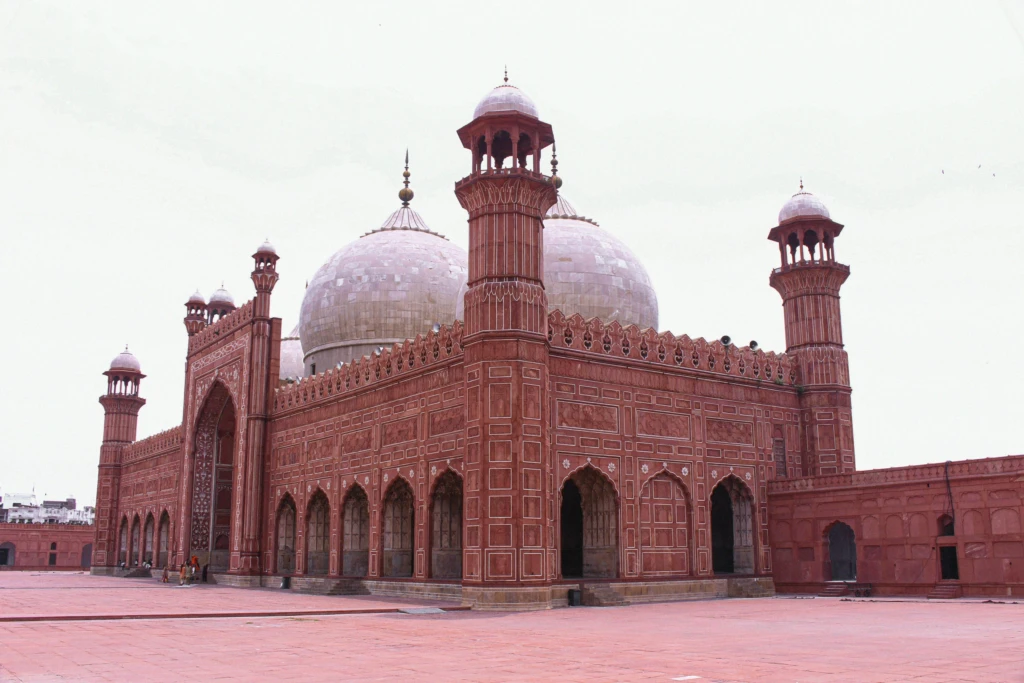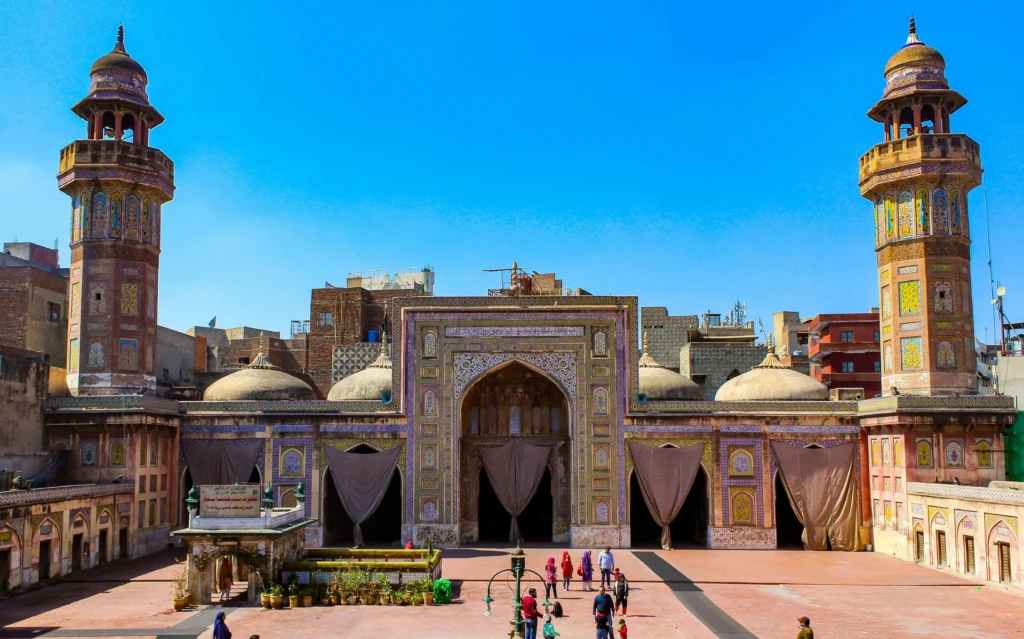Lahore, the cultural capital of Pakistan, is a city steeped in centuries of history, art, and architectural grandeur. For history enthusiasts and travelers alike, the historical sites in Lahore are a treasure trove of stories from the Mughal, Sikh, and British eras. Each monument reflects the legacy of rulers, artisans, and visionaries who shaped the city’s past. From grand forts to sacred shrines and colonial marvels, Lahore invites you to journey through time. Here are the top historical sites in Lahore that you must explore.
1. Lahore Fort (Shahi Qila)
Located in the northwest corner of the Walled City of Lahore, next to the Badshahi Mosque, Lahore Fort is one of the most iconic historical sites in Lahore. Rebuilt during the reign of Mughal Emperor Akbar in 1566 and later expanded by Jahangir, Shah Jahan, and Aurangzeb, this UNESCO World Heritage Site once served as the royal residence of the Mughal emperors. Its architectural brilliance reflects a harmonious blend of Islamic, Persian, and Indian influences.

Key highlights include the glittering Sheesh Mahal (Palace of Mirrors), the elegant Naulakha Pavilion, the monumental Alamgiri Gate, and the vivid Picture Wall adorned with tile mosaics. With underground chambers, audience halls, and a majestic gate, the fort presents a captivating journey into Mughal opulence.
2. Badshahi Mosque
Standing directly opposite Lahore Fort, the Badshahi Mosque is a grand symbol of Mughal religious architecture and one of the most revered historical sites in Lahore. Built by Emperor Aurangzeb in 1671, the mosque once held the title of the largest in the world. Constructed with red sandstone and white marble inlays, it boasts a vast courtyard capable of accommodating over 55,000 worshippers. The mosque’s grand minarets, intricate calligraphy, and domes are a visual and spiritual marvel. Within its walls lies a museum housing relics of Prophet Muhammad (PBUH), enhancing its religious and cultural significance. The mosque’s commanding presence and historical depth make it a must-visit landmark.

3. Shalimar Garden
The Shalimar Garden, situated on the Grand Trunk Road northeast of Lahore, are a magnificent example of Mughal landscape design and among the most enchanting historical sites in Lahore. Commissioned by Shah Jahan in 1641, the garden follows the Persian concept of paradise gardens, divided into three terraces with over 400 fountains, marble pavilions, and flowing water channels. This royal retreat once served as a serene escape for the emperors and still reflects the symmetry, harmony, and tranquility that define Mughal garden aesthetics. The aged trees, floral arrangements, and water features create a picturesque scene that transports visitors to the era of Mughal leisure.

4. Minar-e-Pakistan
Located in Iqbal Park near the Walled City, Minar-e-Pakistan is a modern monument steeped in historical significance and a key destination among historical sites in Lahore. It marks the spot where the All-India Muslim League passed the Lahore Resolution on March 23, 1940—a pivotal step towards the creation of Pakistan. Designed to reflect a blend of Islamic and modern architectural elements, the tower stands 70 meters high with inscriptions of the resolution in several languages. The surrounding gardens and pools add a sense of serenity, while the monument itself stands as a national symbol of identity, unity, and independence.

5. Tomb of Jahangir
Nestled in Shahdara Bagh across the Ravi River, the Tomb of Jahangir is a serene and majestic reminder of Mughal grandeur and one of the most refined historical sites in Lahore. Built in 1637 by his son Shah Jahan, the tomb is set in a lush Charbagh-style garden. The structure is made of red sandstone and marble, decorated with pietra dura floral patterns and intricate frescoes. The central white marble cenotaph is inscribed with Quranic verses, and four minarets guard its corners. Nearby are the tombs of Jahangir’s wife Noor Jahan and brother-in-law Asif Khan, making this area a significant Mughal necropolis.

6. Wazir Khan Mosque
Tucked within the bustling Walled City near Delhi Gate, the Wazir Khan Mosque is a vibrant jewel among historical sites in Lahore. Commissioned by Wazir Khan, the governor of Lahore under Shah Jahan, and completed in 1641, the mosque is renowned for its exquisite “kashi kari” tile mosaic work and frescoes. Its courtyard, prayer halls, and minarets are adorned with intricate floral and geometric patterns, Quranic calligraphy, and vibrant colors. This mosque stands as a masterpiece of Mughal decorative art, offering both spiritual serenity and artistic inspiration amid the hustle of the surrounding bazaar.

7. Hazuri Bagh and Baradari
Situated between the Badshahi Mosque and Lahore Fort, Hazuri Bagh and its central baradari (pavilion) offer a glimpse into the Sikh era of Lahore’s history. Built in 1818 by Maharaja Ranjit Singh to commemorate the acquisition of the Koh-i-Noor diamond, the white marble baradari once stood three stories tall before being damaged by an earthquake. The garden, designed in the Mughal style, complements the surrounding architecture and serves as a peaceful gathering space. This location remains a picturesque and historically layered site that connects Mughal, Sikh, and colonial legacies.

8. Chauburji
One of the most recognizable landmarks in Lahore, Chauburji stands on Multan Road and marks the remnants of a grand Mughal garden built in 1646. As its name suggests, the gateway features four distinct minarets, each adorned with intricate tile work and inscriptions. Though the garden it once led to has vanished, the structure remains a powerful symbol of Mughal architectural elegance. Its blend of floral motifs, calligraphy, and pointed arches continues to fascinate visitors and scholars alike, preserving the memory of Lahore’s green past.

9. Delhi Gate and the Walled City
Delhi Gate, the eastern entrance to the historic Walled City, was once one of 13 gates that provided access to Mughal-era Lahore. Facing toward Delhi, it was among the most important gates for travelers and traders. Restored under the Walled City of Lahore Authority’s conservation efforts, the gate now serves as the starting point for heritage trails that explore the city’s ancient core. Surrounding the gate are bustling bazaars, historic mosques, and restored havelis, offering an immersive glimpse into Lahore’s urban and cultural evolution. Walking through Delhi Gate is like stepping into a living museum of South Asian heritage.

Conclusion: Embracing the Legacy of Historical Sites in Lahore
Exploring the historical sites in Lahore is more than a visual experience—it’s a journey into the rich cultural, political, and spiritual history of the subcontinent. Whether you’re strolling through Mughal gardens, admiring intricate frescoes, or standing where emperors once ruled, each location offers a profound connection to the past.
So, if you’re a history lover or an adventurous traveler, Lahore awaits with open arms. These monuments, mosques, and tombs are more than relics—they are timeless guardians of our collective memory.
Plan your journey to discover the unparalleled charm of the historical sites in Lahore.

